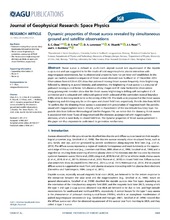| dc.contributor.author | Chen, Xiangcai | |
| dc.contributor.author | Han, Desheng | |
| dc.contributor.author | Lorentzen, Dag Arne | |
| dc.contributor.author | Oksavik, Kjellmar | |
| dc.contributor.author | Moen, Jøran Idar | |
| dc.contributor.author | Baddeley, Lisa | |
| dc.date.accessioned | 2018-02-09T13:35:30Z | |
| dc.date.available | 2018-02-09T13:35:30Z | |
| dc.date.issued | 2017-03 | |
| dc.Published | Chen X, Han, Lorentzen DA, Oksavik K, Moen JI, Baddeley L. Dynamic properties of throat aurora revealed by simultaneous ground and satellite observations. Journal of Geophysical Research - Space Physics. 2017;122(3):3469-3486 | eng |
| dc.identifier.issn | 2169-9402 | en_US |
| dc.identifier.issn | 2169-9380 | en_US |
| dc.identifier.uri | https://hdl.handle.net/1956/17377 | |
| dc.description.abstract | Throat aurora is defined as south-north aligned auroral arcs equatorward of the dayside cusp aurora and was suggested to be the results of cold magnetospheric plasma interaction with magnetopause reconnection, but its observational properties have not yet been well established. In this paper we carefully examine a sequence of throat auroras observed over Svalbard on 27 December 2003. Observations from 630.0 nm [OI] show that poleward moving throat auroras frequently show brightening followed by dimming in auroral intensity, and sometimes, the brightening throat aurora is a precursor of poleward moving auroral forms. Simultaneous all-sky images and HF radar backscatter observations along geomagnetic meridian show that the throat aurora brightening is drifting with ionospheric E × B convection and is colocated with enhanced spectral width poleward of the convection reversal boundary (CRB), while its dimming tends to be in the vicinity of the CRB. This leads us to propose that the throat aurora brightening and dimming may be on the open and closed field lines, respectively. Particle data from NOAA 16 confirm that the dimming throat aurora is associated with precipitation of magnetosheath-like particles mixed with magnetospheric ions (>30 keV), which is characteristic of the low-latitude boundary layer. For particle data from Defense Meteorological Satellite Program F16, we notice that the dimming throat aurora is associated with lower fluxes of magnetosheath-like electrons accompanied with magnetospheric electrons, which is most likely on closed field lines. The dynamic properties of throat aurora presented in this paper are thus important to understand its generation mechanisms. | en_US |
| dc.language.iso | eng | eng |
| dc.publisher | American Geophysical Union | en_US |
| dc.relation.uri | http://onlinelibrary.wiley.com/doi/10.1002/2016JA023033/abstract | |
| dc.title | Dynamic properties of throat aurora revealed by simultaneous ground and satellite observations | en_US |
| dc.type | Peer reviewed | |
| dc.type | Journal article | |
| dc.date.updated | 2018-01-29T17:54:42Z | |
| dc.description.version | publishedVersion | en_US |
| dc.rights.holder | Copyright 2017 American Geophysical Union. All Rights Reserved. | en_US |
| dc.identifier.doi | https://doi.org/10.1002/2016ja023033 | |
| dc.identifier.cristin | 1454944 | |
| dc.source.journal | Journal of Geophysical Research - Space Physics | |
| dc.relation.project | Norges forskningsråd: 223252 | |
| dc.relation.project | Norges forskningsråd: 208006 | |
| dc.relation.project | Norges forskningsråd: 230996 | |
